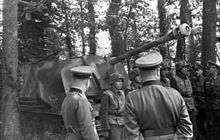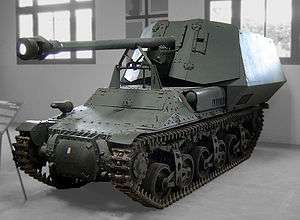Marder I
| Marder I | |
|---|---|
|
Marder I on display at the Musée des Blindés at Saumur. | |
| Type | Tank destroyer |
| Place of origin | Nazi Germany |
| Service history | |
| In service | 1942–1944 |
| Used by | Nazi Germany |
| Wars | World War II |
| Production history | |
| Designed | 1942 |
| Number built | 170 |
| Specifications | |
| Weight | 8,200 kg (18,078 lbs) |
| Length | 5.38 m (17 ft 8 in) |
| Width | 1.88 m (6 ft 2 in) |
| Height | 2 m (6 ft 7 in) |
| Crew | 4 to 5 |
|
| |
| Armor | 5-12 mm |
Main armament | 7.5 cm PaK 40 |
| Engine |
Delahaye 103TT 70 PS (69 hp, 51.5 kW) |
| Power/weight | 8.4 hp (6.3 kW) / tonne |
Operational range | 135-150 km (84-93 mi) road |
| Speed |
34-38 km/h (21-23 mph) road 15-20 km/h (9-12 mph) off-road |
The Marder I "Marten" (Sd.Kfz. 135) was a German World War II tank destroyer, armed with the 75 mm anti-tank gun. Most Marder Is were built on the base of the Tracteur Blindé 37L (Lorraine), a French artillery tractor/armoured personnel carrier of which the Germans had acquired more than three hundred after the Fall of France in 1940.
History

From the early stages of Operation Barbarossa the Wehrmacht became aware that their abililty to combat some of the Soviet tanks was inadequate. The lighter tanks then in general service, such as the Panzer II and the Czech built 38(t) were under-armoured and did not mount an adequate gun to deal with the newer Soviet tanks. In addition, the standard towed anti-tank gun of the Wehrmacht, the 37 mm Pak 36, was both difficult to get into position quickly and lacked the ability to penetrate the heavy sloped armour of the new Soviet tanks. What was needed was a more powerful anti-tank gun that was mobile. The Germans possessed such a gun in the 75 mm PaK 40. They also had come into possession of a large number of captured Soviet 76 mm F-22 Model 1936 divisional field guns. The Germans had experience in taking the chassis of an undergunned tank to provide mobility to a heavier gun. The Panzerjäger I is such an example, where the turret was removed for an open conversion to allow the gunners the necessary room to operate the gun.
With the shock of having units overrun by new Soviet T-34s and KV-1s, the need for a heavier-gunned German tank became urgent. As an interim solution, it was decided to use captured French vehicles such as the Lorraine, and less effective Wehrmacht tanks such as the Panzer II and 38(t) as the basis for makeshift tank destroyers. The result was the Marder series, comprising the Marder I, Marder II, and Marder III respectively. These vehicles provided mobility to either the captured Soviet 7.62 cm Pak 36(r) gun or in later versions the German 75 mm PaK 40 anti-tank gun. Due to the weight and space constraints of the small chassis, the Marder series were not fully armored. Thin upper armor protection was provided only for the front and sides against shrapnel and small arms only. All Marder series had open tops. Some were issued with canvas covers to protect the crew from the elements. The Marder series were not a proper Panzerjäger that could exchange shells with enemy tanks.
Development

The Marder I was developed in May 1942 by Major Alfred Becker. It carried the 75 mm PaK 40 anti-tank gun on a Lorraine chassis. As the gun was relatively large, the original crew compartment superstructure was removed to create the space needed to work the gun. This was done at Baustokommando Becker. The gun was then mounted atop the chassis. Alkett, working in conjunction with Becker, produced the angled armour shielding for the crew compartment.[1] The shielding was relatively light, and was open from above. The shielding provided the crew with protection from blast and small arms fire, but was not intended to stop armour piercing rounds. The vehicle's primary function was to provide mobility to the anti-tank gun. It was not intended as a replacement for a main battle tank.
Between July and August 1942, 170 Marder I's were built on the Lorraine chassis. Later, several other French and Polish tanks were used as the conversion base for the Marder I, including the Hotchkiss H39 and FCM 36. These conversions were also completed at Baustokommando Becker, though fewer of these were built. The Marder Is initially served in infantry divisions on the Eastern Front and met with good success. They later made up a significant component of the armoured fighting vehicles of the reformed 21st Panzer Division in Normandy.
Combat history
The first Lorraine-based Marder I vehicles were sent to the Eastern Front in 1942 to serve in the Panzerjäger (tank destroyer) units of infantry divisions.
This is a list of Infantry Divisions operating on the Eastern Front known to have used Marder I's and the estimated time frame they were used
| Division | Battalion | Time Frame |
|---|---|---|
| 31.Inf. Div | Pz. Jg.Abt.31 | Aug 42 - Dec 43 |
| 35.Inf. Div | 2.Kp./Pz. Jg.Abt.35 | Sep 42 - Dec 43 |
| 36.Inf. Div (mot) | 4.Kp./Pz. Jg.Abt.38 | Oct 42 - Jun 43 |
| 72.Inf. Div | 3.Kp./Pz. Jg.Abt.72 | Sep 42 - Dec 43 |
| 206th Inf. Div. | 1./Pz. Jg.Schn. Abt.206 | Jan 43 - Dec 43 |
| 256.Inf. Div | 5./Pz. Schnelle-Abt.256 | Nov 42 - Apr 44 |
Gallery
 Marder I being prepared to detrain
Marder I being prepared to detrain Marder I towing its ammunition trailer
Marder I towing its ammunition trailer Marder I with driver visible
Marder I with driver visible Men of the 6th Airborne investigate a destroyed Marder I, on H-35 chassis
Men of the 6th Airborne investigate a destroyed Marder I, on H-35 chassis
See also
- ZiS-30, Similar Soviet vehicle, mounting an anti-tank gun on an artillery tractor
References
- ↑ Restayn, Jean Kommando Becker. German Military Magazine (in German)(see External links)
External links
| Wikimedia Commons has media related to Marder tank destroyer. |
- Marder I (Panzerjaeger Lr S 7,5 cm Pak 40/1 on French chassis), Catalog of Enemy Ordnance, U.S. Office of Chief of Ordnance, 1945
- Marder Series, Achtung Panzer
